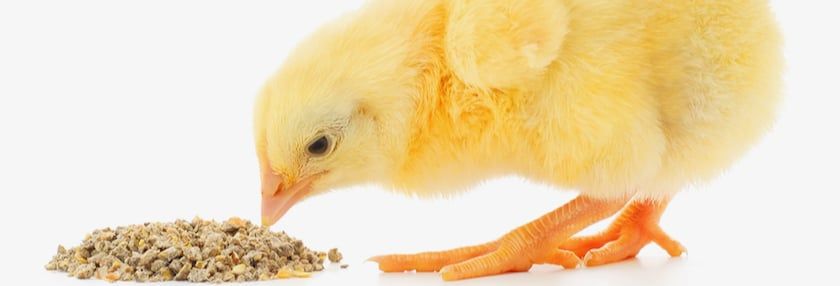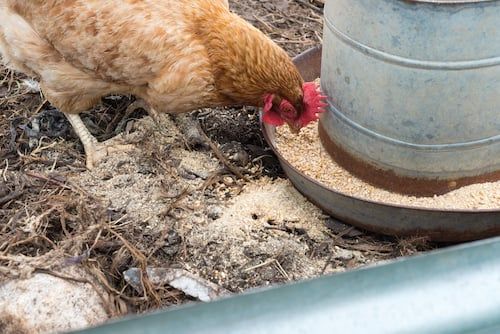What’s the Best Poultry Diet?


Depends on age, breeds, and use—here’s how to unpack it all
Let’s set the stage by beginning at the beginning.
Baby chicks must be provided proper nutrition to grow up healthy and productive. During the first week of post-hatch life, a flurry of rapid development is occurring; most notably in the gastrointestinal and immune systems.
Nutrient requirements for amino acids are the highest that they will ever be and while energy requirements are higher than they will be as an adult laying hen, energy needs will increase as a chick grows and, in the case of a meat bird, will increase indefinitely.
While it’s important to provide the proper nutrients at the right time, management and environment can’t be overlooked. Any points of stress directly affect growth, health, and nutrient requirements.
What’s the gut instinct?
At hatch, the residual yolk sac is the only source of energy and nutrients. Chicks can utilize the nutrients within and survive on the yolk sac alone for some time. Recent research with commercial broiler chickens has shown that withholding feed and water for up to 40 hours did not negatively affect growth performance or feed conversion measured at 35 days of age.
However, we know that delayed feeding leads to slower gastrointestinal tract and immune system development, poor resistance to diseases and pathogens, and may have adverse effects on long-term performance.
We often keep chickens for years, so while they may look just fine at 1 or 2 months old after an early bout of feed or water deprivation, that doesn’t mean that vitality or egg production haven’t been affected down the road.
Another point to consider is that although chickens demonstrate a remarkable ability to compensate for early nutritional deficits, most backyard flock starter feeds are not optimized in amino acid or energy density.
Vitamin and mineral levels may also be marginal in typical chick starters. That’s a major reason that if given a choice between a cheap starter with medication or a more expensive non-medicated starter with proper nutrient density, the latter is the better of the two almost every time. There’s simply no drug that can make up for 3 to 4% crude protein, 0.3 to 0.4% digestible lysine, or 200 to 300 kcal/lb of energy.

Feed: Lots of variables, plenty of numbers
Poultry diets can be formulated in various ways. For the cheapest chick starter, you would formulate the diet using a minimum amount of protein, fat, and phosphorus. Protein would be set at 18% and you wouldn’t worry about digestibility or anti-nutrients.
On the other end of the spectrum, a diet formulated using ideal amino acid ratios to digestible lysine, metabolizable energy of at least 1,350 kcal/lb, non-phytate phosphorus of at least 0.43%, a minimum of non-starch polysaccharides, and enzymatic-removal of the majority of dietary phytate would cost $2 per bag more at a minimum. Add any products to improve immune readiness, nutrient digestibility, gut integrity, etc. and the gap widens. That’s a big difference if you are talking about horse feed and feeding one of several horses that each eat 12 lb of feed per day.
However, between 1 and 7 days of age, an ISA Brown chick consumes around 11 grams of feed per day. That’s approximately the weight of four and a half pennies. By 21 days of age, they are consuming around 25 grams per day. In all, cumulative starter feed consumption may be around 5 lb per bird.
In other words, if you have a flock of 10 chicks, it would cost $0.20 to $0.40 more per bird ($2 to $4 for the flock) to give them an excellent start and lay the foundation for years of productive laying.
Low inputs, low results
The value of proper starter nutrition becomes clear if you think about the value of each dozen eggs a hen will lay in her lifetime compared to a one-time investment of 25 cents. Even if birds look good through the starter and grower phases, a low nutrient density diet can have long-term effects.
Research has shown that layer pullets may be able to reach the same body weight by the point of lay even on a low protein diet.
However, egg production of birds fed lower crude protein diets during the pullet phase suffers from then on even when they are fed the same layer diet. In addition to less eggs, eggs from layers that were reared on low protein diets are smaller. One study found that feeding a lower crude protein diet from 0 to 6 weeks of age resulted in lesser egg production 5 months later!
Another disadvantage to low crude protein diets in the rearing phase is increased mortality in the layer phase. Multiple studies have found that mortality increases during peak lay corresponding with increasing egg weight in birds fed low crude protein diets during rearing.
That’s why it’s really not a good idea to feed treats or grains while birds are growing. At 3 weeks of age when birds may be big enough to consume some scratch feed or whole grain, only about 9 grams or the weight of three and a half pennies would dilute feed intake by 30%.
With an 18% protein starter, that would drop crude protein down to around 13 to 15%, way below the requirement of 21 to 23%. Protein is a good example, but all nutrients are affected. For example, when birds are eating such small amounts of feed, it wouldn’t take much of a treat with 3% sodium to increase water consumption and potentially cause wet litter.

Life is more than feed
While nutrition is important, let’s not forget the importance of proper management. If birds don’t have free access to clean water and feed, then no amount of nutrition can make up for it.
If you use nipple or cup drinker lines and hanging tube feeders, then it is extremely important to watch for small chicks that may get left behind. If it is only difficult but not impossible to access feed and water that chick may be able to catch up with some extra care, but if the problem isn’t noticed right away, they may get too far from the average bird size to keep up.
It’s also very important to make sure that water is fresh and that whatever equipment you use for water delivery is clean and free from dirt, biofilm, or chicken excreta.
Since the European Union ban on antibiotic growth promoters, several companies have developed natural solutions that work as well or better than common in-feed drugs. But no solution is perfect, drug or not. Practicing proper bio-security and keeping a clean, healthy environment will minimize any disease challenge and allow your birds to get the most benefit from a properly formulated diet and any feed additives within.
Chickens only consume a small amount of feed, so let’s invest in them and give them the nutrition they need for a strong start. It will pay dividends down the road for their health, production, and well-being. But we can’t just work on nutrition without considering management.
Keeping your birds’ environment clean and stress-free is your best bet for raising healthy, happy chickens no matter what kind of feed you choose.
Tags:Feed4Thought

Chicken Whisperer is part of the Catalyst Communications Network publication family.









